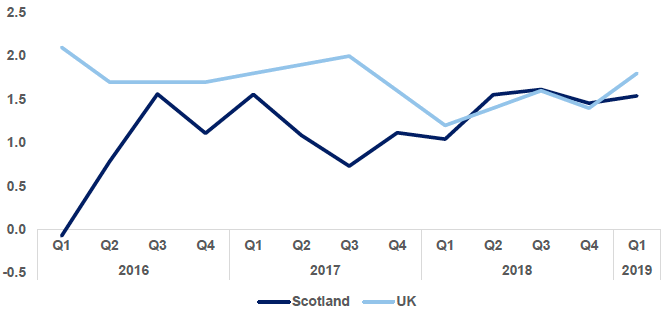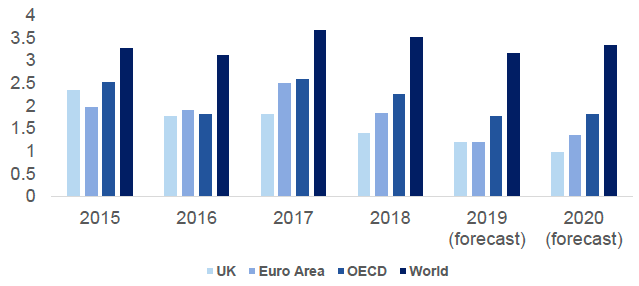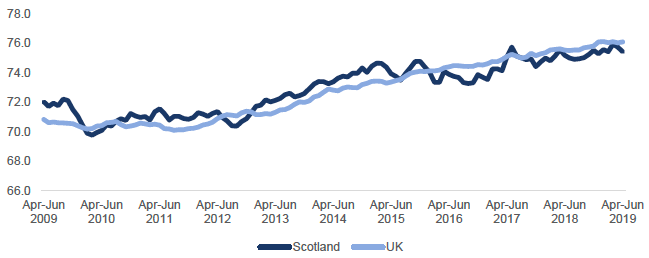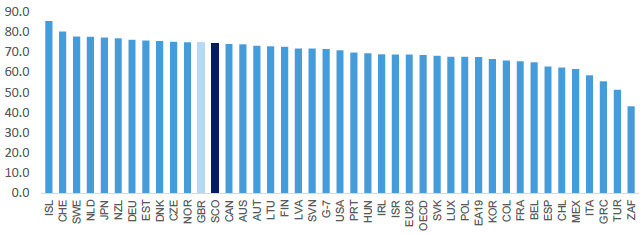Future Skills Action Plan for Scotland: evidence and analysis annex
An evidence paper to accompany Scotland’s Future Skills action plan.
Understanding Scotland’s Economy and Labour Market
29. Scotland’s recent economic performance has proven resilient in the face of domestic and international challenges. Economic growth remains below the pre-2008 recession trend but has kept pace with the UK throughout 2018 and into 2019 (Figure 3).
Figure 3: GDP growth compared to same quarter last year (%), 2016-2019

Source: Scottish Government (2019), ’GDP Quarterly National Accounts, Scotland 2019 Quarter 1’.
30. However, Scotland and the UK’s economic performance has lagged behind the Euro area since the 2016 Brexit referendum. Although annual economic growth (GDP) for the UK and the Euro Area is expected to broadly converge in 2019, forecasts for economic growth in 2020 show a growing divergence between UK GDP growth and the Euro Area, OECD and World averages (Figure 4).
Figure 4: Real GDP growth, annual (%), out-turn and forecast, 2015-2020

Source: OECD, ‘Real GDP Forecasts’, accessed on June 2019.
31. Despite this recent period of economic uncertainty, Scotland’s labour market has proven especially strong compared with historical trends, breaking records on employment (75.9%, Feb-Apr 2019) and unemployment (3.2%, Jan-Mar 2019).[28]
32. In the past decade, there have been intervals where Scotland’s employment rate has outperformed or underperformed compared with the UK. However, broadly, Scotland’s employment rate has closely tracked the UK’s (Figure 5).[29]
Figure 5: Employment rate (16-64) %, 2009 to 2019, UK and Scotland

Source: Office for National Statistics, Labour Force Survey, Apr-Jun 2019.
33. The UK and Scottish labour markets are also performing strongly when compared with international competitors – with employment rates higher than the G7, EU28 and OECD averages (Figure 6).[30]
Figure 6: Employment rates %, (15-64), Q4 2018

Source: OECD (2019), ‘Employment Rate’, accessed on June 2019, and NISRA-ONS (2019), ‘Labour Force Survey Oct-Dec 2018’, Scottish Government calculations.
34. For some other key labour market indicators, Scotland has outperformed the UK in recent times. The employment rate for women in Scotland reached a record high in Feb-Apr 2019 (72.7%) and has been equal or higher than in the UK in almost every monthly labour market release for the past 17 years.[31]
35. At 6.1%, youth unemployment (ages 16-24) in Feb-Apr 2019[32] in Scotland was also lower than any other time on record and substantially lower than in the UK (10.3%, ages 16-24, Feb-Apr 2019).
36. In summary, headline economic and labour market indicators show Scotland’s economy to be in a relatively strong position. However, there are existing and emerging challenges for our labour market with particular implications for our skills system but also inclusive growth, through the five outcomes of productivity, population, participation, people and place.
Contact
Email: Dominic.Mellan@gov.scot
There is a problem
Thanks for your feedback